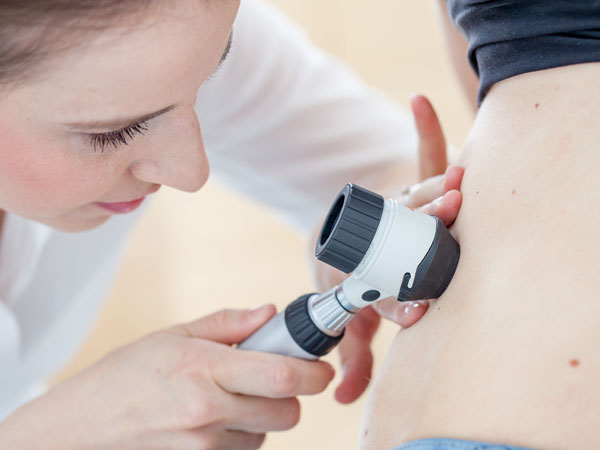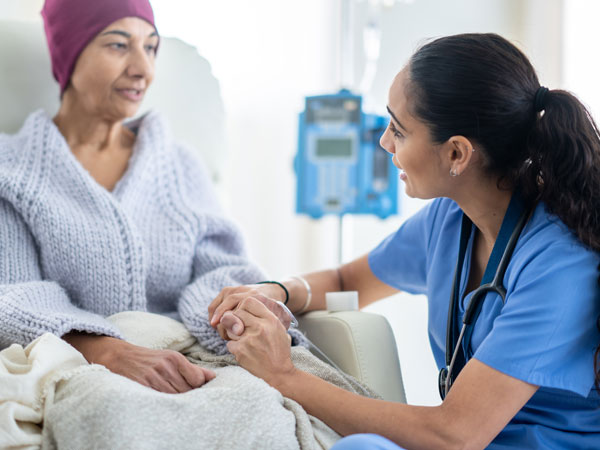- Home
- Science
- Diseases & Conditions
- Melanoma
What is Melanoma?
Melanoma is a cancer of the skin that forms in skin cells known as melanocytes. These cells give the skin its pigmentation or color. In melanoma, melanocytes enter an uncontrolled growth cycle leading to cancer.1 Types of melanoma skin cancer include cutaneous melanoma, mucosal melanoma, and ocular (uveal) melanoma. Cutaneous melanoma may also be called malignant melanoma, though all melanomas are cancerous even if this word isn’t used.2
Melanoma may begin as a mole or appear on skin that does not have moles.3 When melanoma occurs, it is more likely to spread throughout the body than other types of skin cancer, such as squamous cell carcinoma or basal cell carcinoma.1
Prevalence of Melanoma
People living in parts of the world that receive intense sunlight, like those closer to the equator, tend to experience higher rates of melanoma. Worldwide, incidence rates of melanoma have increased over the past several decades, predominately in fair-skinned people living in North America, Northern Europe, Australia, and New Zealand. Melanoma is comparatively less common in Pacific Island nations, South America, Africa, and Asia.4
The American Cancer Society estimates there will be 104,960 new cases of melanoma in the US in 2025, with 60,550 cases in people assigned male at birth and 44,410 in people assigned female at birth. About 8,430 people are expected to die of melanoma in 2025, including an estimated 5,470 people assigned male at birth and 2,960 people assigned female at birth.5
The prevalence of melanoma differs among age groups in the US. Since the early 2000s, melanoma rates among people assigned female at birth ages 50 and over have increased by 3% each year. Among people assigned male at birth in the same age group, rates stabilized during the same timeframe. In those under 50, rates have been stable for people assigned female at birth, while declining by 1% each year for people assigned male at birth.5
Melanoma mortality rates declined among adults in the US from 2013 to 2022, in large part due to better treatment options.5
Causes and Risk Factors

What Causes Melanoma?
Ultraviolet (UV) light is one known cause of melanoma. UV light can come from the sun or from indoor tanning beds and lamps.6
UV light is a carcinogen, meaning it is known to cause cancer. UV light exposure damages DNA inside of skin cells. The body has processes to repair the cells, but mutations may arise once the damage accumulates past a certain point. These mutations can lead to cancer. When mutations accumulate in melanocytes, the resulting cancer is melanoma.6
While UV light is a primary driver of melanoma, there are other causes. Notably, in rare cases, melanoma can be passed down in families.6
Melanoma Risk Factors
Like many diseases, melanoma may affect some people more than others. While anyone can develop melanoma regardless of risk factors, certain risk factors make a person more susceptible to melanoma. These include:6,7
- UV light from the sun or tanning beds
Tanning-bed UV light can be even stronger than the sun.
- Excessive time in the sun without skin protection
Hats, pants, and long sleeves can protect skin from the sun, as can applying water-resistant, broad-spectrum sunscreen of sun protection factor (SPF) 30 or higher.8
- Being over the age of 50
Melanoma risk increases with age, but younger people can also develop it.
- Naturally red or blond hair, fair skin, and/or light-colored eyes
People with these traits tend to have skin that is more sensitive to UV radiation.
- A sunburn that blistered
Blistering indicates serious damage to skin cells.
- A weakened immune system
Melanoma risk increases when the immune system is weak, which can be caused by certain medical treatments or conditions such as HIV.
- The presence of 50 or more moles, one large mole, or one or more moles that are atypical
While most moles are harmless, certain features of moles carry a higher melanoma risk.
- A family history of melanoma
In certain rare instances, melanoma runs in families.
- A previous case of melanoma or another type of skin cancer
Previous melanoma or other skin cancer indicates that skin was damaged at some point.
- Thyroid or breast cancer
These cancers also increase the risk of melanoma.
It’s important to note that having one or multiple risk factors does not guarantee that a person will develop melanoma. Melanoma prevention is important regardless of risk factors.9
Melanoma Prevention
People can prevent melanoma by taking precautions to avoid ultraviolet (UV) light exposure. The American Academy of Dermatology advises the following practices to protect the skin and prevent skin cancer:10
- Stay in the shade
UV radiation from the sun is at peak strength from 10 a.m. to 2 p.m. Seek shade when outdoors during these hours.
- Wear clothes that protect your skin from the sun
If you plan to be out in the sun, wear appropriate clothing, including long-sleeved shirts, hats with wide brims, pants, and sunglasses with adequate UV shielding. Clothing with ultraviolet protection factor (UPF) labels offer more effective protection.
- Use and reapply sunscreen
Apply sunscreen if you’re venturing outdoors, even when the sky is cloudy. Sunscreen should cover any area that isn’t shielded by clothing. The average adult needs a minimum of one ounce of sunscreen to protect their entire body. Don’t neglect places such as the crown of your head, tops of your ears and feet, and your neck. When choosing a sunscreen, select an option with broad-spectrum protection from UVA and UVB rays. Reapply sunscreen at least every two hours when outdoors or after sweating or swimming.
- Avoid using tanning beds
Tanning bed use can lead to skin cancer. Self-tanning products are a safer alternative. Sunscreen should still be used together with self-tanning products.
- Take care around sand, snow, and water
All these surfaces can reflect sunlight and lead to sunburn.
- Perform regular skin self-examinations
When detected early, melanoma is more likely to be treatable. Monitor your skin and see a dermatologist if you notice any new or suspicious spots on the skin, or any spots that itch, bleed, or are changing.11
Types of Skin Cancer
Melanoma and nonmelanoma are the two main types of skin cancer. Melanoma is rare, while nonmelanoma skin cancer types, such as basal cell carcinoma and squamous cell carcinoma, are more common.12
There are several types of melanoma, including cutaneous melanoma, mucosal melanoma, and ocular melanoma.2 Cutaneous melanoma starts in the skin, while mucosal melanoma occurs in mucous membranes.12 Ocular (also called intraocular or uveal) melanoma forms in eye tissue and is rare.12
There are several subtypes of cutaneous melanoma, including superficial spreading melanoma, nodular melanoma, acral melanoma, and amelanotic melanoma.2 Acral melanoma develops in areas of the body typically not exposed to sunlight, including the palms of the hands, soles of the feet, and underneath the nails.12,13 Amelanotic melanoma is melanoma that does not have the appearance of typical melanomas and can be more difficult to identify.2,14
Melanoma Signs and Symptoms

Generally, melanoma does not resemble skin in the surrounding area. It can take the form of a mole that’s changing or a new age spot or freckle that looks different from nearby areas. Sometimes melanoma has a jagged border.15
Melanoma symptoms typically involve the following:15
- An area on the skin that looks different from nearby areas
- A new age spot, freckle, or mole that crops up and doesn’t resemble others
- An area of the skin that has a spiky border, contains different colors, or is changing in size
- An area on the skin that has thickened, resembling a scar
- A growth or spot on the skin that is uncomfortable, itches, bleeds or causes pain
- A dome-shaped growth that may bleed
- Beneath a fingernail or toenail: a black or dark-brown vertical line
Melanoma may be more treatable when detected early. While some people face a greater risk of melanoma, anyone can develop this type of cancer. Self-exams of the skin are a critical step in melanoma detection.10,11
Dermatologists developed the ABCDEs of melanoma to help people identify possible melanoma on the skin:15,16
- Asymmetry
If the area in question does not divide into two matching halves, take note.
- Border
Be alert if the spot's edges are poorly defined, uneven, or notched.
- Color
A variety of colors within the spot—such as brown, blue, white, red, or black—can be a warning sign.
- Diameter
While melanomas often exceed 6 millimeters in diameter (roughly pencil eraser size), they may be smaller.
- Evolving
Keep an eye on any alterations in the spot, whether it be in size, shape, or color.
Melanoma Complications
Melanoma and the treatment process may lead to complications, such as:17
- Infection: Surgery and additional treatments may increase the risk of infection.
- Anxiety/depression: These conditions may arise from feelings about the cosmetic outcomes after surgery.
- Scarring: The melanoma itself or treatment can cause scarring.
- Metastases: This occurs when melanoma reaches other parts of the body.
- Lymphedema: This is the accumulation of lymph fluid under the skin in areas where fat cells have collected.18
- Local recurrence: People experience this when melanoma returns to the primary tumor site, regional lymph nodes, or the area between the two.19

Diagnosis and Treatment
Melanoma Diagnosis
Early detection may improve the odds of successfully treating melanoma.10 People who notice changes related to the ABCDEs of melanoma may consider an appointment with a dermatologist. During the appointment, a physician or other healthcare provider may conduct a skin exam, ask about family history of melanoma, and collect general health and symptom information.20
If the dermatologist suspects that the area in question may be cancerous, they may remove part or all of the area and send it to a laboratory for evaluation. This is called a biopsy. A skin biopsy is the only way to know whether the area in question is cancer.20
The dermatopathologist generally shares their findings in a pathology report. If the dermatopathologist finds melanoma, the pathology report will include additional details, such as:20
- How quickly the melanoma is spreading
- What kind of melanoma is present
- How deeply the melanoma has infiltrated the skin
Melanoma Staging
As with other types of cancer, healthcare professionals stage melanoma to better describe and treat the disease. Cancer staging is a way of communicating information about the cancer, such as whether it has spread to other tissues or the size of the tumor. There are different types of staging systems for cancer.21,22
When staging melanoma, healthcare professionals may use a staging system called the TNM system. TNM is an acronym that classifies melanoma according to three criteria:22
Healthcare professionals examine the tumor to determine how thick it is. If the tumor is less than 1 millimeter thick, the chances of it spreading are lower. Risk of the tumor spreading increases with thickness. Healthcare professionals may also look for ulceration of the tumor. Ulcerated tumors have broken skin on the surface of the melanoma and tend to be more serious.
Clinicians check whether the tumor has reached nearby lymph nodes.
Healthcare professionals investigate whether the tumor has spread beyond the primary tumor into other organs. While melanoma can spread to any part of the body, it tends to affect lymph nodes, the lungs, other parts of the skin, the liver, bones, and the brain.
Doctors may use a simplified staging system to describe the melanoma and its progression, which help guide the treatment plan. This system ranges from stage 0 to stage IV.12
Melanoma Treatment
The course of treatment for melanoma hinges on several factors, including the person’s health status, how deeply the melanoma has grown into the skin, and whether it has spread to other body parts. The team treating melanoma—which can include a dermatologist and/or an oncologist—typically creates a care plan specific to each person’s needs. That plan may include the following:20
- Surgery
In surgery, healthcare providers strive to remove the area that contains melanoma. Early melanomas may be treated with either of the following surgical procedures, which physicians perform in their office while the patient is awake:
- Excision: A dermatologist tries to remove the melanoma, along with a small border of healthy skin around the area. This extra step may remove additional nearby cancer cells. When the laboratory receives the tissue sample, a specialist, usually a dermatopathologist, examines it under the microscope to search for cancer cells in the border of healthy skin. If no cancer cells appear, the patient may not need further treatment. If some cancerous cells remain, the patient may need additional treatments.20
- Mohs surgery: This procedure is reserved for melanoma of the hand, neck, or head, where it can be difficult to remove a border of healthy tissue. It is performed by a Mohs surgeon, usually a dermatologist with specialized training in this type of procedure. First, the Mohs surgeon removes the visible portion of the melanoma. Next, the Mohs surgeon removes a thin layer of surrounding skin. While you wait, the surgeon will examine the layer of tissue under the microscope. If the surgeon finds cancer cells, they will remove another layer of skin. This process continues until no more cancer cells are visible in the tissue layer.20,23
- Additional melanoma treatment options
Surgery may be sufficient for treating early melanoma. However, if the melanoma is more advanced, a person may require additional treatments to eliminate cancer cells. Some treatments occur following surgery, while others take place prior to surgery to make the cancerous area as small as possible. Treatment options include:
- Radiation therapy: This may eliminate cancer cells and thwart new ones from growing.20
- Lymphadenectomy: This surgery removes lymph nodes from the body.20
- Targeted therapy: These medications target specific proteins in cancer cells that control cancer growth, proliferation, and spread.24 Currently available targeted therapies for melanoma include treatments that block the BRAF and MEK proteins.25
- Immunotherapy: Immunotherapy medications harness the immune system to attack cancer cells. This typically occurs after surgery, or as a primary treatment if the tumor cannot be removed with surgery.20
- Chemotherapy: These medications can kill cancer cells and some healthy cells. Chemotherapy is less common now that new therapies, such as targeted therapies and immunotherapy, are available.20
- Targeted therapies and biomarker testing for melanoma treatment
Healthcare professionals sometimes use medications to target melanoma cells that have certain genetic changes or proteins, called targeted therapies.26
Targeting the BRAF gene
Roughly half of melanoma cases arise from mutations in the BRAF gene. Melanoma cells with mutations in the BRAF gene make abnormal BRAF proteins that help them grow. Therapies that target abnormal BRAF proteins are called BRAF inhibitors. BRAF inhibitors can be helpful in cases of advanced melanoma that have BRAF mutations.26 To find out whether a BRAF inhibitor might help treat a specific patient, healthcare professionals may suggest testing for BRAF mutations.27 For those who qualify, the standard treatment consists of BRAF inhibitors given in combination with treatment targeting the related MEK protein, called MEK inhibitors.26
Targeting the C-KIT gene
A small number of melanomas have mutations in the C-KIT gene. These mutations are more common in melanomas that occur on:26
- The nails, soles of the feet or palms of the hand (acral melanomas)
- In the mouth or other moist areas (mucosal melanomas)
- Areas of the body that receive a lot of sun
For people who have advanced melanoma that started in one of these areas, doctors might test the melanoma cells for mutations in the C-KIT gene. If the melanoma has these genetic changes, therapies that target cells with these mutations might be helpful.26
Targeting Other Genes
While less common, some melanomas have other genetic changes that can be targeted with specific treatments. For example, targeted therapies are available for melanomas with mutations in the NRAS, ALK, ROS1, and NTRK genes.26
- Other melanoma treatment options
Healthcare professionals may turn to other treatments for melanoma, including:
- Adoptive T-cell therapy: Adoptive T-cell therapy uses the person’s immune system to fight cancer.20 A patient’s blood or tumor sample goes to the laboratory, where professionals isolate cancer-fighting T-cells and then more of them. The person with melanoma eventually receives these cells via injection, sometimes leading to melanoma remission. Tumor-infiltrating lymphocyte (TIL) therapy and chimeric antigen receptor (CAR) T-cell therapy are two forms of adoptive T-cell therapy20,29 These treatments are not yet widely available.20
- Clinical trials: Clinical trials assess the efficacy of new treatments or medications. A doctor may recommend a patient for a clinical trial if the treatment being studied might be helpful. Participation comes with risks and benefits, which people should discuss with their healthcare provider.20
- Palliative care: Palliative care seeks to improve a patient’s quality of life by providing comfort and relief from symptoms, such as pain. It does not treat cancer itself. Even melanoma patients who do not have advanced cancer may receive palliative care.20
Global Impact of Melanoma

An estimated 325,000 new cases of melanoma occurred worldwide in 2020. The same year, 57,000 people globally died from melanoma. Experts predict that instances of melanoma will increase by 50% from 2020 to 2040, reaching 500,000 per year. Projections estimate the number of deaths to increase by two-thirds, hitting nearly 100,000 per year.30
In most regions around the world, melanoma tends to affect more people assigned male at birth than those assigned female at birth.31 Geographically, the highest rates of cutaneous melanoma in 2020 were in Australia, New Zealand, Western Europe, North America, and Northern Europe, respectively. Melanoma is rare in Asia and Africa.32
Frequently Asked Questions About Melanoma
- What is melanoma?
Melanoma is a cancer of the skin. It arises in melanocytes—the type of skin cells that give skin its pigmentation, or color. In melanoma, these skin cells enter an uncontrolled growth cycle, leading to cancer.1
- What are melanoma symptoms?
Melanoma symptoms typically involve the following:15
- An area on the skin that looks different from nearby areas
- A new age spot, freckle, or mole that crops up and looks different from others
- An area of the skin that has a jagged border, contains different colors or is changing in size
- An area on the skin that has thickened or resembles a scar
- A growth or spot on the skin that is uncomfortable, itches, bleeds or causes pain
- A dome-shaped growth that may bleed
- Beneath a fingernail or toenail: a black or dark-brown vertical line
To identify possible instances of melanoma, dermatologists developed the ABCDEs of melanoma:16
- Asymmetry: If the area in question does not divide into two matching halves, take note.
- Border: Be alert if the spot's edges are poorly defined, uneven, or notched.
- Color: A variety of colors within the spot—such as brown, blue, white, red, or black—can be a warning sign.
- Diameter: While melanomas often exceed 6 millimeters in diameter (roughly pencil eraser size), they may be smaller.
- Evolving: Keep an eye on any alterations in the spot, whether it be in size, shape, or color.
- What is malignant melanoma?
Malignant melanoma is another term for melanoma, a cancer of the skin.2 This cancer occurs in melanocytes—the type of skin cells that cause skin to appear different shades and colors. In melanoma, growth of these cells spirals out of control, leading to cancer.1 All melanoma is cancer, even if the word “malignant” is not used.2
- What is nodular melanoma?
Nodular melanoma is a type of melanoma that often resembles the growth of a blood vessel, appearing as a dark brown or black dome-shaped bump. Roughly 15% of melanomas are nodular melanoma. Nodular melanoma is quick to invade nearby tissue. It can affect any surface of the body and is especially common on the torsos of people assigned male at birth.33
- What does early-stage melanoma look like?
Early-stage melanoma, also known as Stage 0 or Stage I melanoma, tends to appear in specific ways. Stage 0 melanoma is contained in the outermost layer of skin, called the epidermis. It hasn’t reached any lymph nodes or other parts of the body. You may hear this type of melanoma called melanoma in situ.15
In stage I melanoma, the tumor is no greater than 2 millimeters thick. It may or may not have ulceration. In this case, the cancer has not spread to lymph nodes in the vicinity or other parts of the body.15
- What does a melanoma mole look like?
To spot potential melanoma, look for the following:15
- An area of skin that looks different than surrounding areas
- A mole with an irregular edge or undergoing changes in size, shape, or color
- A new age spot, freckle, or mole that lacks resemblance to adjacent skin
- A part of the skin that has become thickened or scar-like
- Any area of the skin that causes discomfort, itching, bleeding, or pain
- A dome-shaped growth that is prone to bleeding
- Under a fingernail or toenail, the appearance of a dark brown or black vertical stripe
To recognize potential melanoma, people may use the ABCDEs:16
- Asymmetry: The two halves of the spot do not mirror each other.
- Border: Watch out for edges that are indistinct, irregular, or serrated.
- Color: The spot may display a mix of colors, such as brown, blue, white, red, or black.
- Diameter: Though melanomas are often larger than 6 millimeters across (approximately the size of a pencil eraser), they can be smaller.
- Evolving: Observe any changes in the spot’s dimensions, shape, or color.
Learn More About Melanoma
Find Pfizer clinical trials for melanoma at PfizerClinicalTrials.com.
Explore melanoma clinical trials at ClinicalTrials.gov.
Area of Focus: Oncology
Melanoma is a focus area for Pfizer Oncology. To learn more about how we’re accelerating breakthroughs to outdo cancer, visit the Oncology page.
Find resources for those living with cancer and their caregivers at This is Living with Cancer.
Additional resources:
- References
- What is melanoma skin cancer? American Cancer Society. https://www.cancer.org/cancer/types/melanoma-skin-cancer/about/what-is-melanoma.html. Updated October 27, 2023. Accessed June 4, 2025.
- Types of melanoma. AIM at Melanoma Foundation. https://www.aimatmelanoma.org/melanoma-101/types-of-melanoma/. Accessed June 9,2025.
- Common moles, dysplastic nevi, and risk of melanoma. National Cancer Institute. https://www.cancer.gov/types/skin/moles-fact-sheet. Updated November 17, 2022. Accessed June 4, 2025.
- Matthews NH, Li WQ, Qureshi AA, Weinstock MA, Cho E. Epidemiology of melanoma. In: Ward WH, Farma JM, eds. Cutaneous Melanoma: Etiology and Therapy. Codon Publications; 2017. Accessed June 9, 2025.
- Key statistics for melanoma skin cancer. American Cancer Society. https://www.cancer.org/cancer/types/melanoma-skin-cancer/about/key-statistics.html. Updated January 16, 2025. Accessed June 4, 2025.
- Skin cancer types: Melanoma causes. American Academy of Dermatology Association. https://www.aad.org/public/diseases/skin-cancer/types/common/melanoma/causes. Accessed June 4, 2025.
- Skin cancer risk factors. Centers for Disease Control and Prevention. https://www.cdc.gov/skin-cancer/risk-factors/index.html. Updated July 1, 2024. Accessed June 4, 2025.
- Sun protection factor (SPF). U.S. Food & Drug Administration. https://www.fda.gov/about-fda/center-drug-evaluation-and-research-cder/sun-protection-factor-spf. Updated July 14, 2017. Accessed June 4, 2025.
- Risk factors for melanoma skin cancer. American Cancer Society. https://www.cancer.org/cancer/types/melanoma-skin-cancer/causes-risks-prevention/risk-factors.html. Updated October 27, 2023. Accessed June 4, 2025.
- How to prevent skin cancer. American Academy of Dermatology Association. https://www.aad.org/public/diseases/skin-cancer/prevent/how. Updated January 21, 2025. Accessed June 4, 2025.
- Can melanoma skin cancer be found early? American Cancer Society. https://www.cancer.org/cancer/types/melanoma-skin-cancer/detection-diagnosis-staging/detection.html. Updated August 14, 2019. Accessed June 4, 2025.
- Melanoma treatment (PDQ)-patient version. National Cancer Institute. https://www.cancer.gov/types/skin/patient/melanoma-treatment-pdq. Updated May 16, 2025. Accessed June 4, 2025.
- Acral melanoma. National Cancer Institute. https://www.cancer.gov/publications/dictionaries/cancer-terms/def/acral-melanoma. Accessed June 4, 2025.
- Kakish DR, AlSamhori JF, Ayman A, et al. Amelanotic melanoma: Diagnostic challenges, treatment innovations, and the emerging role of in early detection. Journal of Medicine, Surgery, and Public Health. 2025;6(100189). Accessed June 9, 2025.
- Skin cancer types: melanoma signs and symptoms. American Academy of Dermatology. https://www.aad.org/public/diseases/skin-cancer/types/common/melanoma/symptoms. Accessed June 4, 2025.
- What to look for: ABCDEs of melanoma. American Academy of Dermatology. https://www.aad.org/public/diseases/skin-cancer/find/at-risk/abcdes. Accessed June 4, 2025.
- Heistein J, Acharya U, Kumar S, Mukkamalla R. Malignant Melanoma. StatPearls. https://www.ncbi.nlm.nih.gov/books/NBK470409/. Updated February 17, 2024. Accessed June 4, 2025.
- What is lymphedema? American Cancer Society. https://www.cancer.org/cancer/managing-cancer/side-effects/swelling/lymphedema/what-is-lymphedema.html. Updated May 20, 2025. Accessed June 4, 2025.
- Perez MC, Tanabe KK, Ariyan CE, et al. Local and recurrent regional metastases of melanoma. In: Balch CM, Atkins MB, Garbe C, et al., eds. Cutaneous Melanoma. Springer International Publishing; 2019:705-737.
- Diagnosis and treatment. American Academy of Dermatology Association. https://www.aad.org/public/diseases/skin-cancer/types/common/melanoma/diagnose-treat. Accessed June 4, 2025.
- Cancer staging. National Cancer Institute. https://www.cancer.gov/about-cancer/diagnosis-staging/staging. Updated October 14, 2022. Accessed June 4, 2025.
- American Cancer Society. Melanoma skin cancer stages. Updated October 27, 2023. Accessed June 4, 2025. https://www.cancer.org/cancer/types/melanoma-skin-cancer/detection-diagnosis-staging/melanoma-skin-cancer-stages.html. Accessed June 4, 2025.
- What is Mohs Surgery? American Academy of Dermatology Association. https://www.aad.org/public/diseases/skin-cancer/types/common/melanoma/mohs-surgery. Updated May 17, 2021. Accessed June 9, 2025.
- Targeted therapy to treat cancer. National Cancer Institute. https://www.cancer.gov/about-cancer/treatment/types/targeted-therapies. Updated May 31, 2022. Accessed June 9, 2025.
- The role of targeted therapy in treating advanced melanoma. Melanoma Research Alliance. https://www.curemelanoma.org/blog/the-role-of-targeted-therapy-in-treating-advanced-melanoma. March 20, 2023. Accessed June 4, 2025.
- Targeted therapy drugs for melanoma skin cancer. American Cancer Society. https://www.cancer.org/cancer/types/melanoma-skin-cancer/treating/targeted-therapy.html. Updated October 27, 2023. Accessed June 4, 2025.
- Zhou S, Sikorski D, Xu H, et al. Defining the criteria for reflex testing for BRAF mutations in cutaneous melanoma patients. Cancers. 2021;13(9):2282.
- Randic T, Kozar I, Margue C, Utikal J, Kreis S. NRAS mutant melanoma: Towards better therapies. Cancer Treatment Reviews. 2021;99:102238.
- Phillips C. First cancer TIL therapy gets FDA approval for advanced melanoma. National Cancer Institute. https://www.cancer.gov/news-events/cancer-currents-blog/2024/fda-amtagvi-til-therapy-melanoma. March 5, 2024. Accessed June 4, 2025.
- Melanoma awareness month 2022. World Health Organization. https://www.iarc.who.int/news-events/melanoma-awareness-month-2022/. May 2, 2022. Accessed June 4, 2025.
- Melanoma strikes men harder. American Academy of Dermatology Association. https://www.aad.org/public/diseases/skin-cancer/types/common/melanoma/men-50. Accessed June 9, 2025.
- Arnold M, Singh D, Laversanne M, Vignat J, Vaccarella S, Meheus F, Cust AE, de Vries E, Whiteman DC, Bray F. Global Burden of Cutaneous Melanoma in 2020 and Projections to 2040. JAMA Dermatol. 2022 May 1;158(5 ):495-503.
- Types of melanoma. National Cancer Institute. https://training.seer.cancer.gov/melanoma/intro/types.html. Accessed June 4, 2025.
The information contained on this page is provided for your general information only. It is not intended as a substitute for seeking medical advice from a healthcare provider. Pfizer is not in the business of providing medical advice and does not engage in the practice of medicine. Pfizer under no circumstances recommends particular treatments for specific individuals and in all cases recommends consulting a physician or healthcare center before pursuing any course of treatment.




